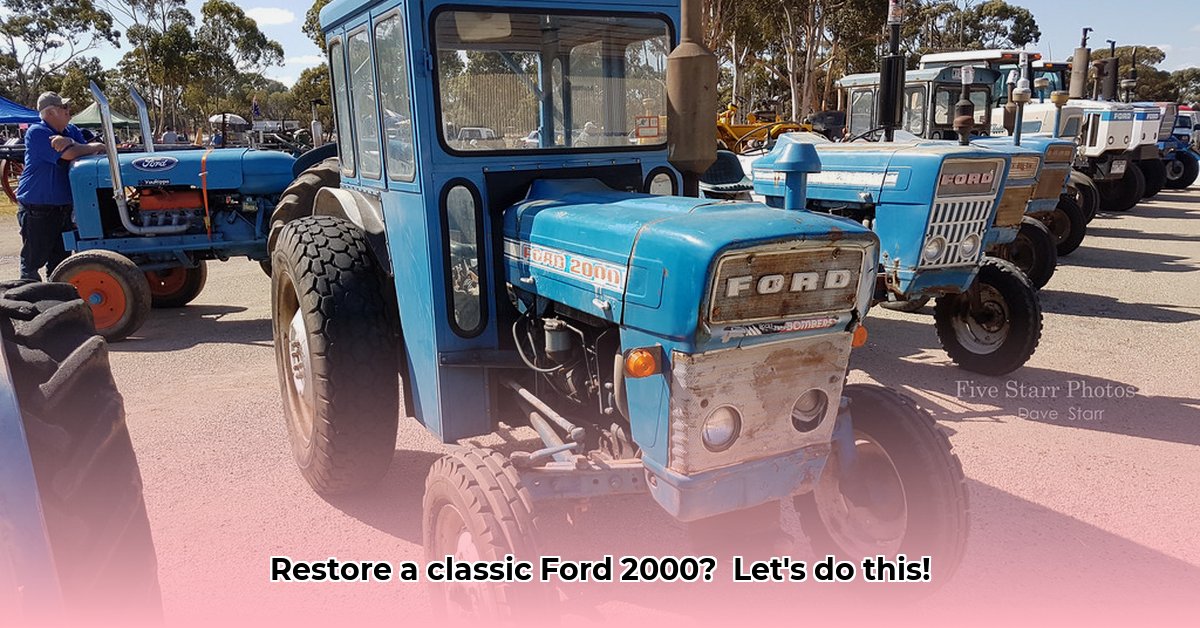
The 1970 Ford 2000 tractor: a symbol of rugged dependability and agricultural heritage. This guide provides owners, restorers, and enthusiasts with a comprehensive resource for maintaining and restoring this classic machine. Whether you're tackling a routine oil change or a full engine rebuild, this guide offers the technical expertise and practical advice you need. For information on similar vintage tractors, check out this helpful resource on 1951 Ford tractors.
Technical Specifications & Overview: Understanding Your Ford 2000
The Ford 2000, produced from 1968 to 1979, is a versatile, two-wheel-drive tractor known for its simple yet robust design. While variations exist across production years, the 1970 model typically features a 2.6-liter three-cylinder engine (available in gasoline or diesel variants), an unsynchronized transmission (offering various gear configurations), and a reliable three-point hitch hydraulic system. The lack of power steering on base models was common for the era but significantly impacts ease of operation.
| Specification | Description | Notes |
|---|---|---|
| Engine | 2.6L, 3-cylinder (gasoline or diesel) | Diesel offers more torque; gasoline offers simpler maintenance. |
| Transmission | Unsynchronized, variable speeds (4-12) | Requires practice for smooth shifting. |
| PTO (Power Take-Off) | Standard | Crucial for powering implements. |
| Hydraulic System | Three-point hitch | Capacity can vary slightly depending on the model and year. |
| Fuel Tank Capacity | Varies by model and fuel type | Check your owner's manual for specific details. |
| Optional Features | Power steering, front-end loader | Significantly enhance usability and value. |
Operational Guide: Starting, Operating, and Safe Practices
Before starting your Ford 2000, always perform the following safety checks:
- Fluid Levels: Inspect engine oil, coolant, hydraulic fluid, and fuel. Low levels indicate possible leaks which should be addressed promptly.
- Tire Pressure: Ensure adequate tire inflation for optimal traction and performance.
- Visual Inspection: Check belts, hoses, and other external components for damage.
Starting procedures vary slightly depending on the engine type (gasoline or diesel). Consult your owner's manual for detailed instructions. Remember, understanding your tractor's specific features is key. The unsynchronized transmission requires a smooth clutch operation for gear changes. Avoid abrupt movements to prevent gear damage.
Crucially: Always operate the tractor in a safe manner. Wear appropriate safety gear, including a seat belt, and be fully aware of your surroundings. This minimizes risks greatly.
Maintenance & Repair: Keeping Your Ford 2000 Running Smoothly
Regular maintenance is essential for optimal performance and longevity. Here's a basic schedule:
- Oil Changes: Follow the recommended interval in your owner's manual, using the correct oil type and viscosity.
- Filter Replacements: Replace air, fuel, and oil filters as needed. Dirty filters hamper performance and can damage other components.
- Fluid Level Monitoring: Regularly check and maintain proper levels of coolant, hydraulic fluid, and transmission fluid. Leaks require immediate attention.
- Brake Inspection: Inspect brake system components for wear regularly and replace as needed. Safe operation depends on reliable brakes.
- Belt and Hose Inspection: Regularly check the condition of belts and hoses, replacing worn or damaged ones. Failure of these can lead to more extensive and costly repairs.
Restoration Guide: Bringing Your Ford 2000 Back to Life
Restoring a Ford 2000 is a significant undertaking that requires patience and skill. Here's a general approach:
- Assessment: Thoroughly inspect the tractor, documenting the condition of each component. Prioritize repairs based on severity.
- Parts Sourcing: Finding parts for older tractors can be a challenge. Online forums, salvage yards, and specialized suppliers are potential sources.
- Mechanical Restoration: If significant mechanical issues exist, this could include engine rebuilds, transmission overhauls, or hydraulic system repairs.
- Cosmetic Restoration: Repainting the tractor, replacing decals, and refurbishing accessories would come after the mechanical work.
Parts Sourcing & Availability
Finding parts for a 1970 Ford 2000 requires persistence. Online forums dedicated to vintage tractors and agricultural equipment salvage yards are invaluable resources. Keep in mind that original parts may be scarce. Exploring aftermarket or reproduction parts might be necessary.
Conclusion: The Lasting Legacy of the Ford 2000
The 1970 Ford 2000 remains a testament to durable engineering. Although parts sourcing can be challenging and modern features are lacking, its simplicity and versatility appeal to enthusiasts and farmers alike. With proper care and maintenance, this classic tractor can continue to serve its purpose for generations to come. This guide provides a starting point for your journey towards maintaining or restoring this exceptional piece of agricultural history. Remember to consult your owner’s manual for model-specific details and always prioritize safety.